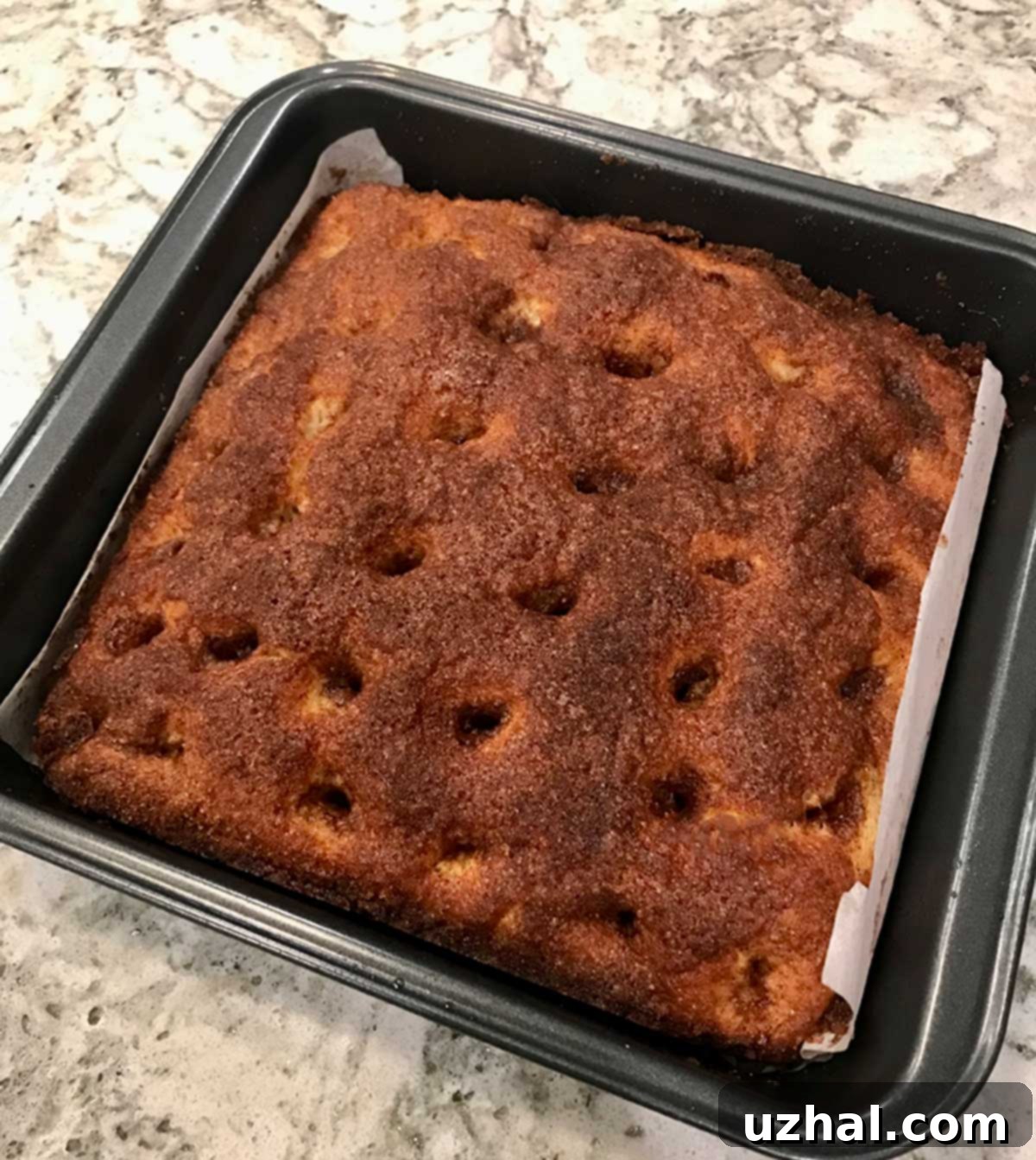Mastering Moravian Sugar Cake: An Easy & Authentic Homemade Recipe Guide
Moravian Sugar Cake holds a special place in the hearts of many, particularly in North Carolina, where its rich history and delectable taste have become synonymous with holiday traditions and community gatherings. For years, I had heard whispers of this legendary sweet treat, often associated with festive occasions and the Moravian Church. It wasn’t until my family and I moved to North Carolina that this culinary curiosity truly piqued my interest. Every Christmas season, without fail, someone would enthusiastically mention making a trip to the Moravian church in Winston-Salem to procure these coveted cakes, often baked by local institutions like Dewey’s Bakery.
Just yesterday, the familiar topic resurfaced. Our kind neighbor stopped by with a plate of homemade shortbread, regretfully mentioning her unsuccessful attempt to get her hands on a Moravian Sugar Cake. We graciously accepted the shortbread, but her comment reignited our resolve. “We’ll just have to make it ourselves,” we declared. And so, thanks to the timeless wisdom found in Richard Sax’s “Classic Home Desserts,” we embarked on our own Moravian Sugar Cake adventure. What we discovered was not just a recipe, but a delightful journey into a beloved tradition, culminating in a cake that exceeded all expectations.
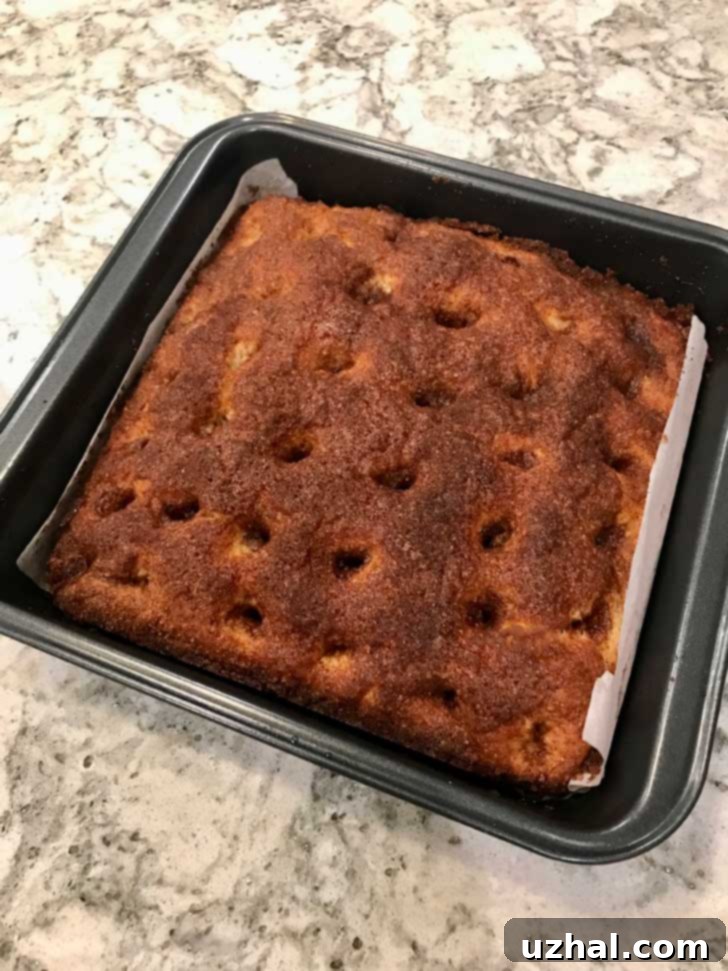
What Is Moravian Sugar Cake? Unraveling Its Sweet Mystery
Before diving into the baking process, let’s address the most common question: What exactly is Moravian Sugar Cake? For a long time, I mistakenly associated it with more intricate and time-consuming pastries like stollen, envisioning a dense, fruit-laden bread. However, I was pleasantly surprised to learn that this assumption couldn’t be further from the truth. Moravian Sugar Cake is, at its heart, a wonderfully light-textured yeasted coffee cake. Its defining characteristics are its soft, fluffy interior and a gloriously crispy, buttery cinnamon-sugar topping that forms an irresistible crust.
Imagine the comforting warmth and tender crumb of your favorite cinnamon rolls, but in a more accessible, cake-like form. That’s essentially the experience of a Moravian Sugar Cake. What makes it even more appealing is the simplicity of its preparation. Unlike cinnamon rolls, there’s no laborious rolling, shaping, or cutting of individual pieces of dough. Instead, the yeast dough is simply pressed into a pan, dimpled, topped with its signature sweet coating, and baked to golden perfection. This ease of preparation, combined with its profound flavor, makes it a perfect choice for bakers of all skill levels, especially during busy holiday seasons or whenever a craving for something truly special strikes. The only “drawback” (if you can even call it that) is how incredibly easy and satisfying it is to make, leading to an almost insatiable desire to bake it over and over again! Though, as I’ve learned, sometimes the best recipes are those that need no alteration at all.
The Richard Sax Legacy: Classic Home Desserts’ Moravian Sugar Cake
Our journey to homemade Moravian Sugar Cake was guided by a revered source: “Classic Home Desserts” by the late, celebrated food writer Richard Sax. Sax’s culinary contributions were immense, and this particular recipe for Moravian Sugar Cake is a testament to his dedication to preserving and sharing beloved American dessert traditions. He notes that this specific recipe was “unearthed” by Karyl Bannister of the “Cook & Tell” newsletter, a detail that immediately piqued my fascination. The idea of food history being “unearthed” and shared through such a charming medium truly speaks to the enduring power of community and culinary heritage. It seems there’s even a book version of “Cook & Tell,” a definite addition to my future wish list!
Sax describes Moravian Sugar Cake as “a deliciously moist yeast dough cake baked in a sheet pan and cut into large squares or rectangles.” His book is not just a collection of recipes; it’s a treasure trove of delightful anecdotes and insights. For instance, there’s a charming side note about a “happy accident” involving a cat – a quirky detail that adds so much character to the book and makes the baking experience feel even more personal and joyful. These fun side notes are a hallmark of Sax’s engaging writing style, making his book a joy to read as much as it is to cook from. His meticulous attention to detail ensures that even complex-sounding recipes are approachable and yield perfect results, as we found with this exceptional Moravian Sugar Cake.
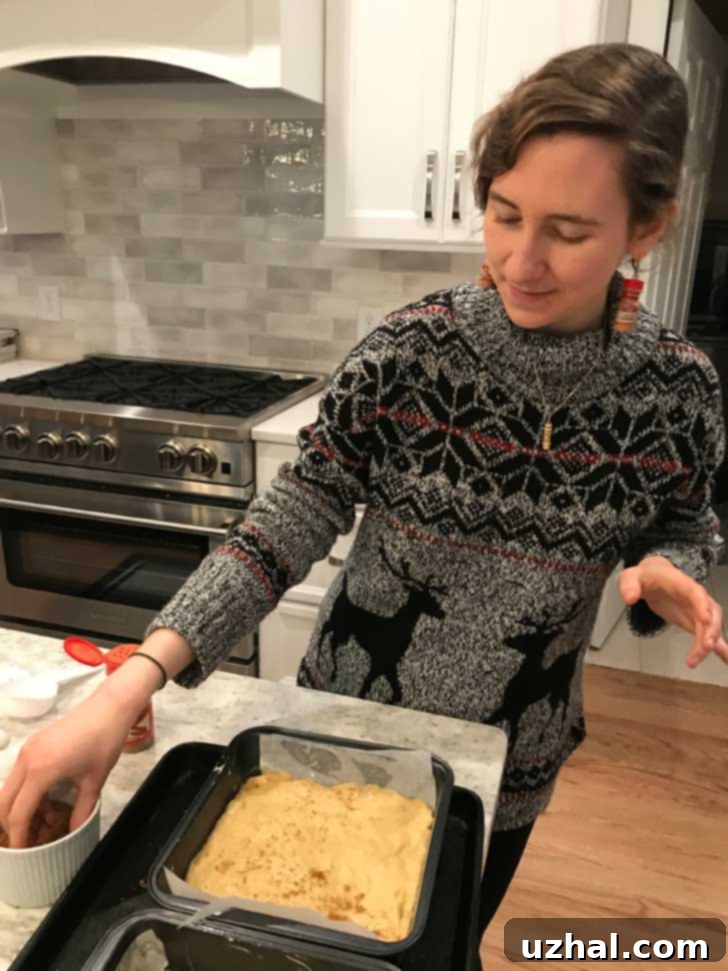
Choosing the Right Moravian Sugar Cake Pan Size
The original recipe in “Classic Home Desserts” by Richard Sax suggests using a jellyroll pan or a 13×9 inch pan, which yields a thinner, flatter cake often cut into generous squares. However, we opted for a slightly different approach that proved to be incredibly convenient and versatile. Since we planned to keep one cake for ourselves and gift another, we decided to divide the dough between two 8-inch square metal pans. This strategy worked beautifully, allowing us to easily transport one of the cakes directly in its pan for holiday gifting.
Using 8-inch pans results in a slightly thicker cake compared to the traditional jellyroll pan. We thoroughly enjoyed this added thickness, finding it provided a more substantial and satisfying bite while still retaining the cake’s characteristic light and airy texture. If you don’t have two matching 8-inch pans, don’t worry! You could likely use one 8-inch and one 9-inch pan without significant issues, though baking times might need slight adjustment. The key is to ensure the pans are well-greased, and for this wonderfully sticky dough, consider lining them with parchment paper for effortless removal. The flexibility in pan choice makes this recipe adaptable to what you have on hand, ensuring you can still enjoy this delightful treat, whether for personal enjoyment or sharing with loved ones.
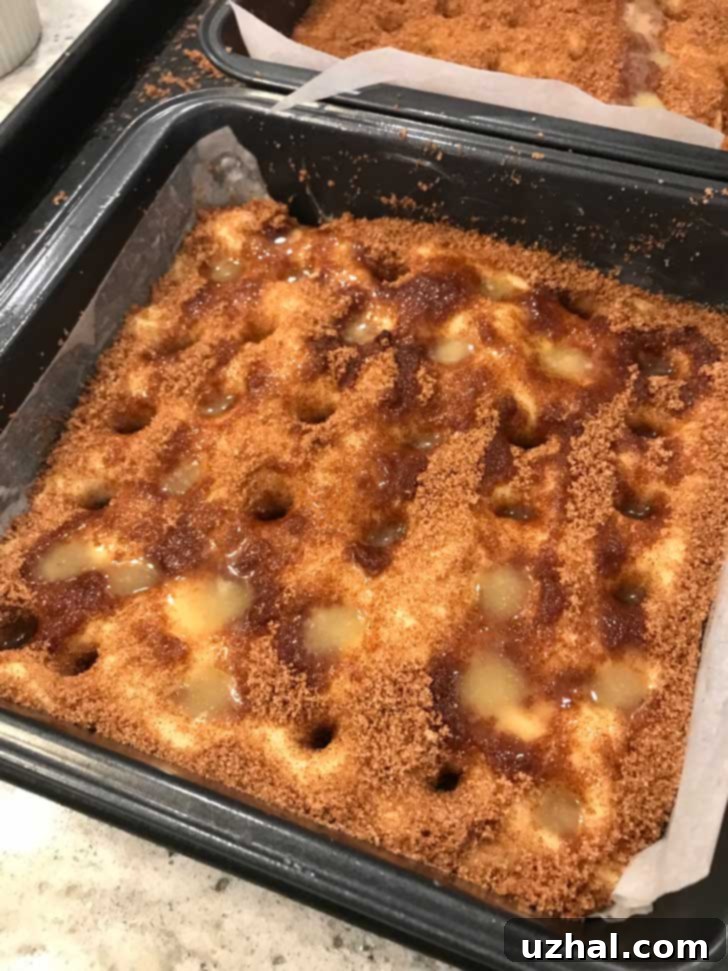
Essential Moravian Sugar Cake Ingredients & Why They Matter
The magic of Moravian Sugar Cake lies in its simple yet effective ingredients, each playing a crucial role in creating its unique texture and flavor. Here’s a closer look at what you’ll need and some tips for best results:
- Yeast: Richard Sax’s recipe calls for a surprisingly generous amount of yeast – 4 ½ teaspoons (or two standard packets) for just 3 cups (380 grams) of all-purpose flour. This is not a typo! This hefty quantity is key to achieving the cake’s signature incredibly light, airy, and fluffy texture, making it rise beautifully and quickly. Always ensure your yeast is active and proof it properly to guarantee a successful rise.
- Milk: The recipe uses milk in a divided fashion. A small ¼ cup is initially combined with the yeast and a tablespoon of sugar to proof it, giving the yeast a warm, sugary environment to activate. The remaining ¼ cup is added later to achieve the perfect dough consistency, contributing to the cake’s overall moisture and tenderness. Use lukewarm milk for optimal yeast activity.
- Sugar: Like the milk, sugar is also divided. One tablespoon is added with the yeast to “feed” it, helping it to become foamy and active. The rest of the granulated sugar sweetens the dough, providing the foundational sweetness for the cake itself.
- Mashed Potato: This is perhaps the most intriguing ingredient and a hallmark of many traditional yeasted cakes and breads, especially in Moravian baking. Mashed potato contributes incredible moisture and tenderness to the dough, creating a softer crumb and extending the cake’s freshness. You can use any kind of mashed potatoes – whether it’s leftovers from dinner (plain, no butter or milk added initially for best control), freshly peeled, boiled, and mashed potatoes, or even reconstituted potato flakes for convenience. We simply peeled, cut, and boiled one large potato, then mashed it until smooth.
- All-Purpose Flour: This forms the structure of the cake. We used standard all-purpose flour. While unbleached flour is often preferred by bakers for slightly better flavor and texture, bleached Gold Medal all-purpose flour worked perfectly well when unbleached wasn’t available, yielding a beautiful result.
- Eggs: Two large eggs enrich the dough, adding moisture, fat, and contributing to the cake’s tender crumb and golden color. It’s crucial to bring them to room temperature before using. Cold eggs can lower the temperature of the dough, inhibiting yeast activity and slowing down the rise.
- Butter: This recipe is generous with butter, providing a rich, tender dough. We recommend using unsalted butter for the dough, as it allows you to control the overall salt content of the cake precisely. Melt it gently and allow it to cool slightly before adding to avoid cooking the yeast or eggs.
- Salt: Essential for balancing the sweetness, enhancing the flavors of the other ingredients, and regulating yeast activity. We used Morton kosher salt, but any fine salt will work.
- Topping Ingredients:
- Brown Sugar: A blend of ½ cup brown sugar and 1 ½ teaspoons of cinnamon creates the iconic crispy, caramelized topping. The recipe specifies light brown sugar, which provides a classic, mellow caramel flavor. However, don’t hesitate to use dark brown sugar if you prefer a deeper, more robust molasses flavor in your topping.
- Cinnamon: The warm, aromatic spice that beautifully complements the sweet brown sugar.
- Melted Butter: Four tablespoons of melted butter are drizzled over the cinnamon-sugar topping just before the final rise and baking. This butter melts into the sugar, creating that irresistible crispy, sweet, and slightly chewy crust. For the topping drizzle, you have a choice: you can add a pinch of salt to unsalted butter to enhance the flavor, or simply use salted butter if you like the contrast it provides. We found that using unsalted butter in the dough and salted butter for the drizzle added an extra layer of flavor complexity.
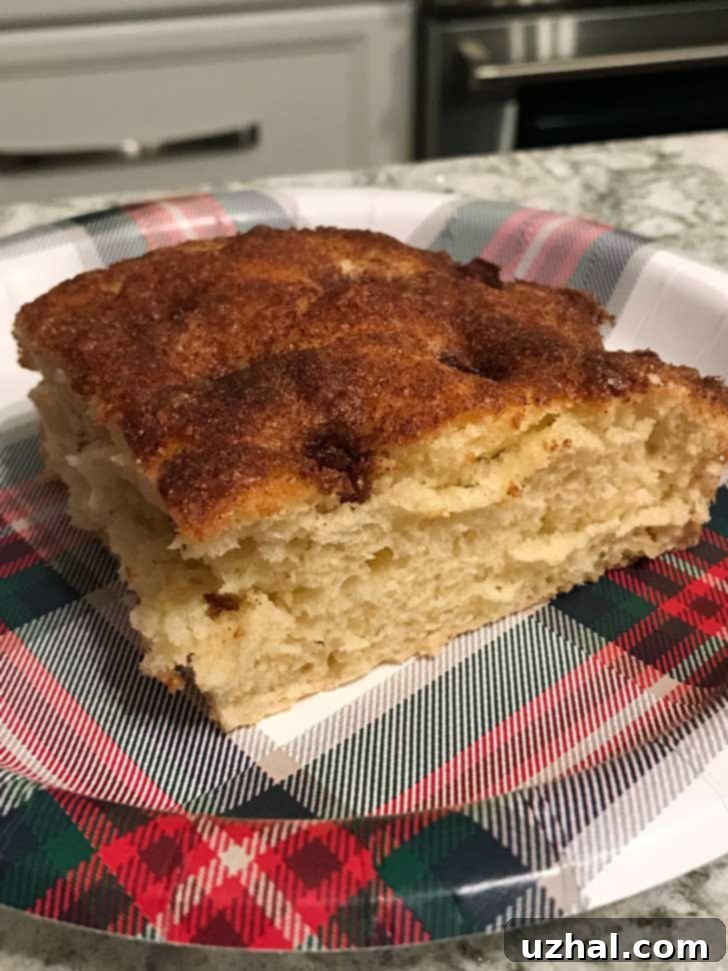
Tips for a Perfect Moravian Sugar Cake
Ensuring a Beautiful Rise
Given the generous amount of yeast in this recipe, it’s crucial to monitor your dough during both rising periods. The first rise, where the dough doubles in bulk, can sometimes happen faster than the suggested 1 hour. Ours, for example, doubled in just 40 minutes! A warm, draft-free environment is ideal for rising. If your kitchen is cool, consider placing the bowl in a slightly warm (but not hot) oven that has been turned off, or near a warm spot.
The Art of Dimpling
The distinctive “dimples” in Moravian Sugar Cake are not just for aesthetics; they serve a functional purpose. These indentations create pockets where the melted butter, brown sugar, and cinnamon collect, forming delightful pools of caramelized sweetness and ensuring every bite has that signature crispy topping. When making the dimples, use the handle of a wooden spoon or your finger, pressing down firmly but being careful not to go all the way through the dough to the bottom of the pan. This technique allows the topping to penetrate slightly without creating holes for the butter to escape entirely.
Baking and Doneness
Baking two 8-inch square pans side-by-side on a larger rimmed baking sheet helps ensure even heat distribution and catches any potential drips. The cake is done when it’s beautifully golden brown on top and the internal temperature reaches around 195°F (90°C). Using an instant-read thermometer is the most accurate way to check for doneness, preventing undercooked dough or overbaked dryness. If the topping starts to brown too quickly, you can lightly tent the cakes with aluminum foil for the last few minutes of baking.
Serving and Storing Your Homemade Moravian Sugar Cake
One of the best qualities of Moravian Sugar Cake is its versatility in serving. It is absolutely heavenly when served warm, with the butter-sugar topping still slightly gooey and the cake incredibly soft. A slice of warm sugar cake with a cup of coffee or tea makes for an exquisite breakfast, brunch treat, or an afternoon pick-me-up. It’s also a fantastic dessert on its own or lightly dusted with a little extra cinnamon.
If you have leftovers (a rare occurrence!), store them at room temperature in an airtight container for up to 2-3 days. The cake remains moist and delicious, though the topping might lose some of its initial crispness. For longer storage, Moravian Sugar Cake freezes beautifully. Wrap individual slices or the entire cooled cake tightly in plastic wrap, then aluminum foil, and freeze for up to 3 months. To enjoy, simply thaw at room temperature or gently warm in a low oven for a few minutes until soft and fragrant again. This makes it an ideal make-ahead treat for holidays or unexpected guests.
- Soda Bread Buns with Fennel Seeds and Cranberries
- Chocolate Chip Apple Bread
- Bundt Cake Dark Chocolate Cake Balls
- Outrageous Chocolate Chip Peanut Butter Cookies
Authentic Moravian Sugar Cake Recipe
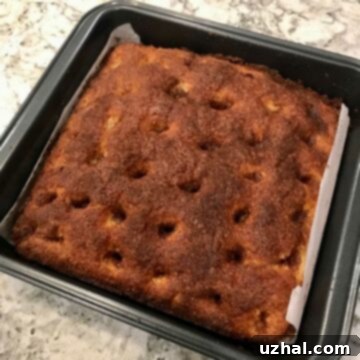
Moravian Sugar Cake
Recipe by Cookie Madness (Adapted from Richard Sax)
Pin Recipe
Ingredients
For the Dough
- ½ cup lukewarm milk, divided use (114 grams)
- 4 ½ teaspoons active dry yeast
- 5 tablespoons granulated sugar, divided use (60 grams)
- 3 cups all-purpose flour (380 grams)
- ½ cup mashed potatoes (plain, unsalted, unbuttered)
- 2 large eggs at room temperature (100 grams)
- 6 tablespoons unsalted butter, melted and slightly cooled (84 grams)
- ½ teaspoon salt
For the Topping
- ½ cup brown sugar (light or dark, 60 grams)
- 1 ½ teaspoons cinnamon
- 4 tablespoons butter, melted and cooled (salted or unsalted) (56 grams)
Instructions
-
In the bowl of a stand mixer, combine ¼ cup of the warm milk, the yeast, and 1 tablespoon of the granulated sugar. Stir gently and let this mixture stand for about 10 minutes, or until the yeast becomes foamy and visibly active. This indicates your yeast is alive and ready to work.
-
Once the yeast is foamy, add the remaining 4 tablespoons of granulated sugar, 1 ½ cups (half) of the all-purpose flour, the mashed potatoes, room temperature eggs, melted and cooled butter, and salt to the bowl. Mix these ingredients well by hand with a sturdy spoon or spatula until you have a loose, sticky, and somewhat shaggy mixture.
-
Now, add the remaining 1 ½ cups of flour. Attach the bowl to your stand mixer and, using the dough hook attachment, mix on low speed for about 2 minutes. Continue mixing until the dough is smooth, cohesive, and just slightly sticky. It should cling to the dough hook and clean the bottom of the bowl as it mixes. Avoid overmixing; a smooth, elastic texture is what you’re aiming for.
-
Lightly grease a large bowl with butter. Transfer the dough to this bowl, turning it once to coat all sides. Cover the bowl tightly with plastic wrap (or a clean kitchen towel) and let it rise in a warm, draft-free place for about 1 hour, or until it has doubled significantly in bulk. Keep a close eye on it, as this recipe’s generous yeast content means it might double in less time (ours was ready in 40 minutes).
-
While the dough is rising, prepare your baking pans. Generously grease two 8-inch square pans with butter. Because this dough is quite sticky, you might also want to line the bottoms with parchment paper for easier removal after baking.
-
Once the dough has risen, gently punch it down to release the air. Divide the dough evenly between the two prepared pans (each pan should hold approximately 14.5 oz of dough). Cover the pans loosely with greased plastic wrap and let the dough rise again for a second time for 30 minutes. This second rise contributes to the cake’s light texture.
-
After the second rise, gently pat the dough to extend it to the edges of the pans, creating an even layer. Using the handle of a wooden spoon or your finger, poke numerous holes (dimples) all over the top surface of the dough. Be careful not to press all the way through to the bottom of the pan; the dimples should create small indentations for the topping.
-
In a small bowl, mix together the brown sugar and cinnamon for the topping. Sprinkle this mixture evenly over the surface of both dimpled cakes. Next, drizzle the ¼ cup of melted butter evenly over the cinnamon-sugar topping. Let the cakes rise for a final 20 minutes while your oven preheats.
-
Preheat your oven to 375 degrees F (190 degrees C).
-
Place the two square pans on a large rimmed baking sheet. Bake for about 20 minutes, or until the cakes are golden brown on top and the internal temperature of the bread reaches approximately 195 degrees F (90 degrees C).
-
Remove from oven and let cool slightly. Moravian Sugar Cake is best served warm, allowing the topping to remain slightly gooey and the crumb incredibly tender. You can also let it cool completely and serve later. This cake freezes beautifully for future enjoyment.
Notes
Conclusion: Embrace the Sweet Tradition
Baking our own Moravian Sugar Cake was more than just following a recipe; it was an immersion into a cherished culinary tradition. The process, surprisingly straightforward, yielded a cake that was every bit as delightful as the ones we’d heard so much about. Its light, airy dough, combined with the caramelized cinnamon-sugar topping, creates a symphony of textures and flavors that is truly comforting and deeply satisfying. This recipe from Richard Sax’s “Classic Home Desserts” proves that sometimes the most beloved treats are also the most accessible for home bakers.
Whether you’re looking to recreate a taste of North Carolina, explore historical American baking, or simply enjoy a fantastic yeasted coffee cake, Moravian Sugar Cake is a perfect choice. It’s a wonderful dish to share during the holidays, at a weekend brunch, or as a special treat for yourself and your family. We encourage you to try this recipe, savor the aroma of it baking in your kitchen, and experience the joy of a truly classic homemade dessert. Happy baking!
